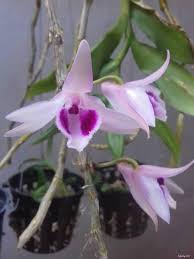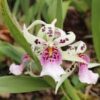### Cleaning Dendrobium Orchid Leaves to Remove Dust and Bacteria

Dendrobium orchids, known for their striking beauty and vibrant flowers, require proper care to thrive. One important aspect of their care is maintaining clean leaves. Dust and bacteria can accumulate on the leaves over time, hindering photosynthesis and potentially leading to diseases. This article provides a comprehensive guide on how to effectively clean the leaves of Dendrobium orchids, ensuring they remain healthy and vibrant.
### 1. Importance of Cleaning Dendrobium Orchid Leaves
**1.1. Enhancing Photosynthesis**
The leaves of Dendrobium orchids play a critical role in photosynthesis, the process by which plants convert light energy into chemical energy. Dust and debris can block sunlight, reducing the plant’s ability to produce food. Clean leaves enhance photosynthesis, promoting healthy growth and vibrant blooms.
**1.2. Preventing Diseases**
Dust and bacteria can lead to various health issues in orchids. A buildup of grime on the leaves can create a conducive environment for pests and diseases. By regularly cleaning the leaves, you can minimize the risk of infections and infestations, ensuring your orchids remain healthy.
**1.3. Improving Aesthetic Appeal**
Clean leaves contribute to the overall appearance of the orchid. Dusty, dirty leaves can detract from the plant’s beauty. Regular cleaning not only keeps the plant healthy but also enhances its visual appeal, making it a stunning centerpiece in any collection.
### 2. Tools and Materials Needed for Cleaning
Before starting the cleaning process, gather the necessary tools and materials:
– **Soft Cloths or Sponges:** Use microfiber cloths or soft sponges to avoid damaging the leaves. Avoid abrasive materials that can scratch the surface.
– **Water:** Clean, lukewarm water is ideal for washing the leaves. It helps dissolve dirt and bacteria without causing shock to the plant.
– **Mild Soap or Cleaning Solution (Optional):** If the leaves are particularly dirty or greasy, a gentle soap solution can be used. Choose a soap that is free from harsh chemicals.
– **Spray Bottle:** A spray bottle can be useful for applying water or cleaning solutions evenly.
– **Towel or Paper Towels:** For drying the leaves after cleaning.
### 3. Step-by-Step Cleaning Process
**3.1. Assessing the Condition of the Leaves**
Before cleaning, examine the leaves for any signs of pests, disease, or damage. If you notice any unusual spots, discoloration, or webs, take appropriate measures to address these issues before cleaning.
**3.2. Preparing the Cleaning Solution**
If necessary, prepare a mild cleaning solution by mixing a few drops of liquid soap in a bowl of lukewarm water. Avoid using strong detergents, as they can harm the orchid.
### 4. Cleaning Techniques
**4.1. Dusting the Leaves**
For light dust accumulation, a simple dusting can suffice. Here’s how to do it:
– **Use a Soft Cloth:** Take a clean, dry microfiber cloth and gently wipe each leaf, starting from the base and moving toward the tip. This method removes surface dust without the need for water.
– **Regular Dusting:** Make dusting a regular practice, ideally once a week, to prevent buildup.
**4.2. Washing the Leaves**
For more stubborn dirt and grime, washing the leaves is necessary. Follow these steps:
– **Soak the Cloth:** Dampen a microfiber cloth or sponge in lukewarm water or the prepared soap solution. Make sure it is not dripping wet to avoid over-saturating the leaves.
– **Wipe Each Leaf:** Gently wipe each leaf with the damp cloth, focusing on the upper and lower surfaces. Use a circular motion to lift off dirt and debris. Be careful not to apply too much pressure, as the leaves can be delicate.
– **Rinse with Clean Water:** If you used soap, it’s essential to rinse the leaves afterward. Use a clean cloth dampened with plain water to wipe away any soap residue.
**4.3. Spray Method for Larger Plants**
For larger Dendrobium orchids with many leaves, a spray method can be more efficient:
– **Fill a Spray Bottle:** Fill a spray bottle with lukewarm water. Optionally, add a few drops of mild soap.
– **Mist the Leaves:** Lightly mist the leaves, ensuring that the water reaches both the top and bottom surfaces. Allow the water to sit for a minute to loosen dirt.
– **Wipe Down:** Use a soft cloth to wipe down the leaves, removing any loosened dirt and debris. Follow up with a clean damp cloth to remove any soap residue.
### 5. Special Considerations
**5.1. Avoiding Water Accumulation**
While cleaning the leaves, take care to avoid excessive water accumulation in the leaf axils (the angle between the leaf stem and the main stem). Standing water can lead to rot and other issues. If water collects in these areas, gently tilt the plant to allow it to drain out.
**5.2. Protecting Sensitive Leaves**
Some Dendrobium varieties have more delicate leaves that can be easily damaged. For these plants, consider using only a damp cloth for cleaning, avoiding any scrubbing or pressure.
### 6. Post-Cleaning Care
**6.1. Drying the Leaves**
After cleaning, it’s essential to dry the leaves properly. Use a soft towel or paper towels to gently pat the leaves dry. Avoid rubbing, as this can cause damage.
**6.2. Environmental Conditions**
Following cleaning, ensure the orchid is placed in a well-ventilated area to facilitate drying. Avoid direct sunlight immediately after cleaning, as this can cause leaf burn, especially on wet leaves.
**6.3. Monitoring for Pests and Diseases**
After cleaning, keep an eye on the orchid for any signs of pests or diseases. Cleaning can disturb pests, making them more visible. Regularly inspecting the plant allows for early detection and treatment.
### 7. Frequency of Cleaning
**7.1. Regular Maintenance**
Cleaning Dendrobium orchid leaves should be a part of your regular orchid care routine. Aim to dust the leaves weekly and wash them every month, or more frequently if they accumulate dust quickly.
**7.2. Seasonal Considerations**
In spring and summer, when Dendrobium orchids are actively growing, they may attract more dust and debris. Increase the frequency of cleaning during these seasons. In fall and winter, you can reduce the cleaning frequency as the plant enters a dormant phase.
### 8. Common Problems and Solutions
**8.1. Leaf Discoloration**
If you notice yellowing or browning of the leaves, it could indicate various issues, such as overwatering, nutrient deficiencies, or insufficient light.
– **Solution:** Assess the watering routine, ensure the orchid is receiving adequate light, and check for nutrient levels in the potting mix.
**8.2. Pests**
Common pests such as aphids, mealybugs, and spider mites can affect Dendrobium orchids. If you notice any pests during cleaning, take immediate action.
– **Solution:** Use insecticidal soap or neem oil to treat affected areas. Be sure to follow the manufacturer’s instructions for application.
### 9. Conclusion
Cleaning the leaves of Dendrobium orchids is a vital practice that enhances their health, promotes photosynthesis, and prevents disease. By following the steps outlined in this guide, orchid enthusiasts can maintain their plants in pristine condition, allowing them to flourish and produce stunning blooms. Regular cleaning not only benefits the plants but also contributes to the overall aesthetic appeal of your indoor garden.
By dedicating time and effort to proper leaf cleaning, you ensure that your Dendrobium orchids remain vibrant and healthy for years to come. Regular maintenance, attention to detail, and proactive care are key to enjoying the beauty and elegance that these remarkable orchids have to offer.

